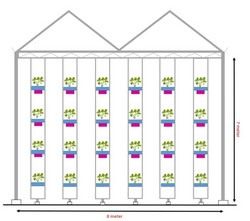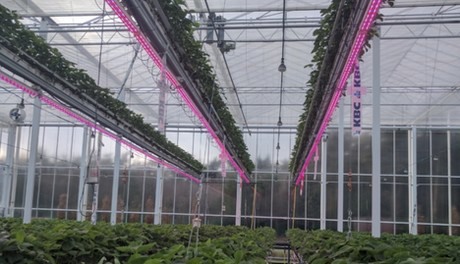 In Hoogstraten (Belgium), strawberries will be grown late this year for the first time in a four-layer system. Below the three upper gutters dimmable LEDs will be suspended to compensate for the light loss on the lower gutters. In recent years, trials have already been conducted at Research Center Hoogstraten with cultivation in a two-layer system with lighting.
In Hoogstraten (Belgium), strawberries will be grown late this year for the first time in a four-layer system. Below the three upper gutters dimmable LEDs will be suspended to compensate for the light loss on the lower gutters. In recent years, trials have already been conducted at Research Center Hoogstraten with cultivation in a two-layer system with lighting.
The multi-layer system is a co-creation within the GLITCH project. GLITCH is a three-year project that strives for more high-tech applications in greenhouse horticulture. For strawberries, the possibilities of four-layer cultivation will be documented through cultivation tests.
Two-layer cultivation was the first successful step
In recent years, Research Center Hoogstraten has conducted tests in a two-layer system with additional lighting. The installation of this system was the first step towards a multi-layer cultivation of strawberries. An 8 meter glass roof with seven cultivation gutters was equipped with three additional higher gutters to which LED modules were attached. The LED lighting provides an additional 30 μmol / m².s PAR light on the underlying layer of gutters during the day. In the two-layer system, they were able to generate the same production per plant on the lower gutters as in a traditional single-layer system.
24 gutters per 8 meter roof
At the end of 2018, the works in Hoogstraten were started to equip a section in the glass greenhouse with three additional layers of gutters. The existing greenhouse has a leg height of 7 m, so that a large space is available at the top. To make optimum use of this space, 24 gutters will be installed in a roof space with a span width of 8 m (see figure). As a result, the cultivation area is more than tripled in size. To compensate for the loss of light on the lower gutters, they will hang LEDs under the three upper gutters.
New cultivation system is tested in continued cultivation
"We first and mainly try to achieve a homogenous light distribution on the lower gutters by installing newly developed dimmable LEDs", the researchers report. "Next, during two seasons, we will evaluate the possibilities of the multilayer system for an autumn crop followed by a secondary crop, and in the summer the first crop will be planted in the multilayer system."
"We will take a closer look at different test objects: the plants that grow on the lower gutters with a lot of artificial light will develop differently than the plants at the top that receive only sunlight. The most important parameters that we will follow are production, grading and fruit quality. In order to map out the climate effect of the high plant density and the use of LEDs, also the relative humidity and temperature will be closely monitored. Finally the results of this multi-layer system will be compared with the results of plants in a traditional single layer system."
Source: GLITCH










